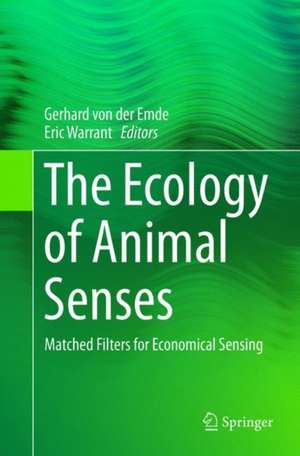The Ecology of Animal Senses: Matched Filters for Economical Sensing
Editat de Gerhard von der Emde, Eric Warranten Limba Engleză Paperback – 28 mar 2019
| Toate formatele și edițiile | Preț | Express |
|---|---|---|
| Paperback (1) | 782.70 lei 38-44 zile | |
| Springer International Publishing – 28 mar 2019 | 782.70 lei 38-44 zile | |
| Hardback (1) | 937.74 lei 3-5 săpt. | |
| Springer International Publishing – 27 dec 2015 | 937.74 lei 3-5 săpt. |
Preț: 782.70 lei
Preț vechi: 1029.87 lei
-24% Nou
Puncte Express: 1174
Preț estimativ în valută:
149.84€ • 154.10$ • 124.31£
149.84€ • 154.10$ • 124.31£
Carte tipărită la comandă
Livrare economică 11-17 februarie
Preluare comenzi: 021 569.72.76
Specificații
ISBN-13: 9783319798004
ISBN-10: 3319798006
Pagini: 269
Ilustrații: X, 269 p. 95 illus., 46 illus. in color.
Dimensiuni: 155 x 235 mm
Greutate: 0 kg
Ediția:Softcover reprint of the original 1st ed. 2016
Editura: Springer International Publishing
Colecția Springer
Locul publicării:Cham, Switzerland
ISBN-10: 3319798006
Pagini: 269
Ilustrații: X, 269 p. 95 illus., 46 illus. in color.
Dimensiuni: 155 x 235 mm
Greutate: 0 kg
Ediția:Softcover reprint of the original 1st ed. 2016
Editura: Springer International Publishing
Colecția Springer
Locul publicării:Cham, Switzerland
Cuprins
Introduction: sensory ecology and matched filters.- Energetic costs of neural tissue and its role in the evolution of sensory organs.- Visual matched filtering in arthropods.- Visual matched filtering in vertebrates.- Auditory matched filtering in invertebrates.- The ecology of olfaction.- The ecology of mechanoreception.- Magnetoreception.- Ecology of infrared sensing.- Matched filtering in two senses of one animal: partitioning of environmental sensing in African weakly electric fish.- The ecology of (active) whisking.
Notă biografică
Prof. Gerhard von der Emde, University of Bonn, GermanyProf. Eric Warrant, University of Lund, Sweden
Textul de pe ultima copertă
Sensory systems have evolved to deal with complex and seemingly infinite sensory information. However, during evolution the morphology and neural circuitry of sensory organs have become “matched filters” for the characteristics of the most ecologically crucial stimuli that need to be detected, suppressing or even rejecting other less important stimuli. Not only do these matched filters allow essential sensory stimuli to be rapidly and reliably extracted for further processing, they do so with the most efficient use of the animal’s limited energy supply. The collection of chapters in this book explore these principles across the senses, in both vertebrates and invertebrates, with a rich smorgasbord of case studies that explain how matched sensory filters are an essential feature in the ecology of animal sensing.
Caracteristici
Elucidates the concept of matched sensory filters as an evolutionary process
Summarizes examples of matched filters in all senses
Outlines the key requirements to energy-efficient senses from a neurobiological perspective
Includes supplementary material: sn.pub/extras
Summarizes examples of matched filters in all senses
Outlines the key requirements to energy-efficient senses from a neurobiological perspective
Includes supplementary material: sn.pub/extras










